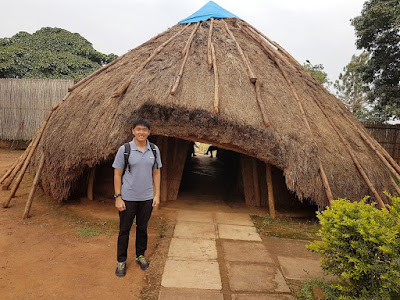CAN: Stanley Park (Part 1)
Stanley Park Causeway, Vancouver, British Columbia, Canada

Surrounded by the waters of Burrard Inlet and English Bay, Stanley Park is Vancouver's first public park. Named after Lord Stanley, 16th Earl of Derby, a British politician who was appointed as the Governor General of Canada from 1888 to 1893, the park has a total area of 405 hectares.

---
CAN: Stanley Park (Part 1) <YOU ARE HERE!>
---
One of the ways to go to the park is to take Bus 19 from the bus stop at West Pender Street, which is a short walk from Waterfront metro station.




































My BFF and I got down at the bus stop along Stanley Park Drive, witnessing a group of bipeds crossing the street.

Would they be able to cross safely? Take a look at the short video clip below.
Vancouver Rowing Club was established in 1886, the same year when the city was incorporated.
 |
| The Clubhouse is a heritage building that was opened in 1911. |


We dropped by at the information booth to take a map. After looking at it closely, we decided to cover the park in an anti-clockwise fashion with a total distance of roughly 8 to 9 km.


Interested in a one-hour tour on a horse carriage? It costs C$50.00 (~S$52.40) per adult and C$22.00 (~S$23.05) per child aged 3 to 12.


We took a short trekking route to see the facade of Vancouver Aquarium.


In addition to being one of Vancouver's major tourist attraction, the aquarium is a centre for marine research, conservation and rehabilitation. It was declared open on 15 June 1956.
 |
| In front of the building is a statue of orca by Bill Reid, a Canadian artist. |


Unlike many large urban parks, Stanley Park isn't designed by landscape architects, but rather the result of the evolution of a forest and urban space over the years. Do call 911 to report a forest fire.

One of the most important features of the park is the seawall. The effortful construction began in 1917 and took several decades to complete.

 |
| One notable individual is James Cunningham, a master mason who dedicated 32 years of his life to the construction of the seawall. |


 |
| Here's a stone tablet spotted in front of a gate leading to a naval base. |


 |
| Crystal clear water~ |
There are a few photo points throughout the park, each with a hint for an Instagram-worthy picture.


There's a patch of grass called Hallelujah Point, where the Salvation Army used to hold Sunday services. It's said that shouts of "Hallelujah!" could be heard across the waters in the city.


Nine O'Clock Gun is another point of interest. The daily firing at 9.00pm allows the chronometers of ships at the ports to be accurately set, as well as serves as a time signal for the general population.

 |
| The cannon was cast in 1816 and brought to Stanley Park in 1894. |

 |
| The cannon was fired for the first time at Stanley Park at 12 noon on 15 October 1898. |
Further ahead is a lookout point built as part of the centennial celebration of the park in 1988.

 |
| Can you see two heaps of yellow-coloured stuff? |

Brockton Point Lighthouse, which overlooks Coal Harbour, marks the easternmost point of the park. That's the best place to see the two bright yellow heaps of elemental sulfur.


Expect lots of squawking seagulls.
Don't forget to check out the totem poles, which are the most-visited tourist attraction in the entire British Columbia.
 |
| That beautifully carved portal is made of red cedar woods. |

 |
| Totem poles are basically the 'coat of arms' of indigenous people. |

There's an interesting sculpture called Shore to Shore, which is a tribute to the ancestral connection between the indigenous people living in the area and the Portuguese communities in the past.


Legends of the Moon is a gift shop located near the totem poles.

 |
| Cans of cuteness! |
There used to be a zoo within the premise of the park, but it closed down in 2011.



Comments
Post a Comment